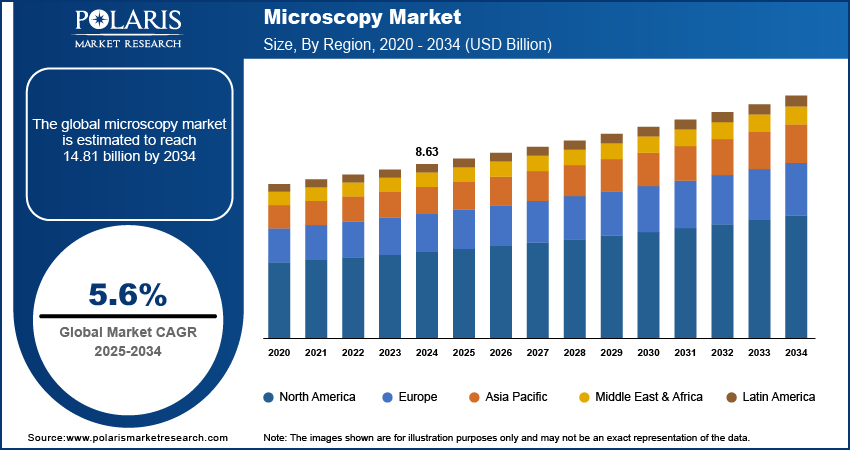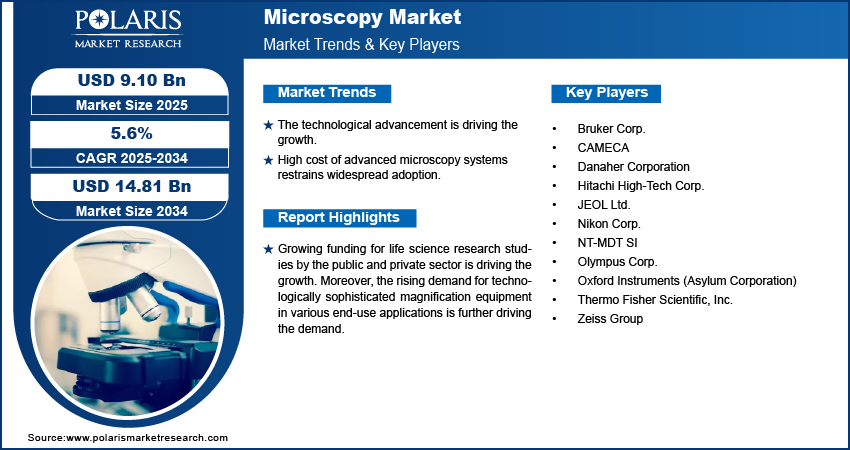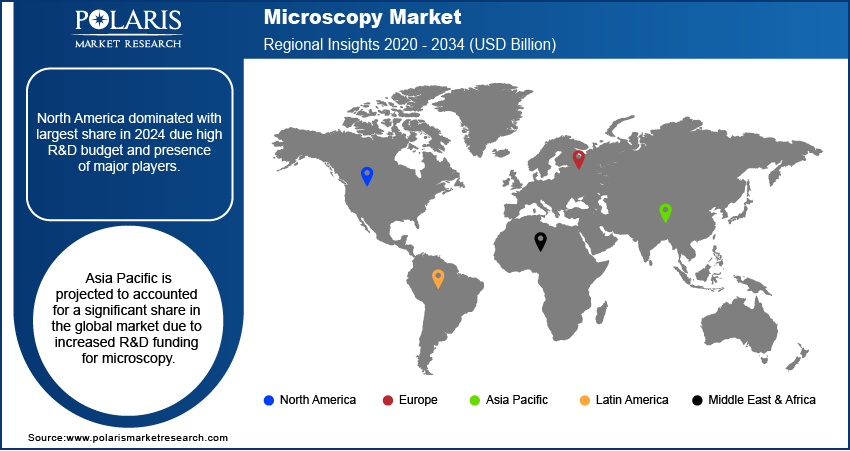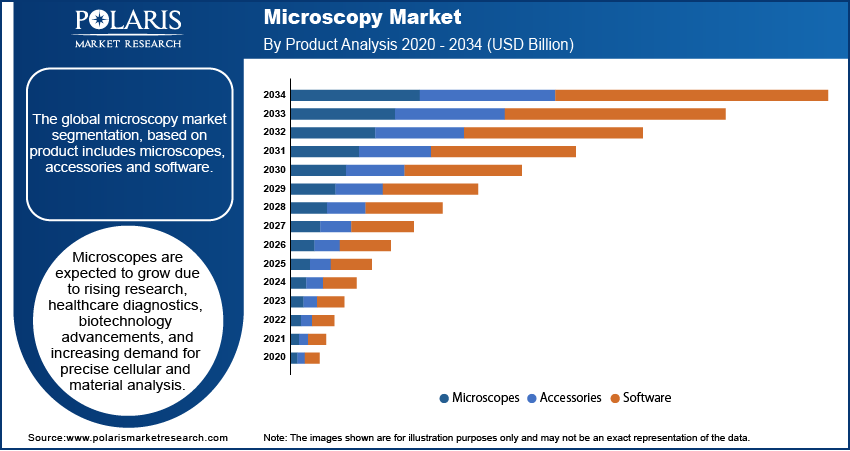
Microscopy Market Size, Share, Trends, & Industry Analysis Report
By Application, By Type, By Product (Microscopes, Accessories), By End-Use, By Region – Market Forecast, 2025–2034
- Published Date:Oct-2025
- Pages: 115
- Format: PDF
- Report ID: PM2705
- Base Year: 2024
- Historical Data: 2020-2023
The microscopy market was valued at USD 8.63 billion in 2024 and is expected to grow at a CAGR of 5.6% during the forecast period. Growing funding for life science research studies by the public and private sector is driving the growth. Moreover, the rising demand for technologically sophisticated magnification equipment in various end-use applications is further driving the demand.
Key Insights
- The optical microscopy is expected to witness significant growth during the forecast period as it is extensively used in microelectronics, nanophysics, biotechnology, pharmaceutic research, mineralogy, and microbiology.
- The semiconductor & electronics segment accounted for the largest share in 2024 driven as they are widely utilized to enhance quality control and development.
- North America dominated with largest share in 2024 due high R&D budget and presence of major players.
- Asia Pacific is projected to accounted for a significant share in the global market due to increased R&D funding for microscopy.
Industry Dynamics
- The growth of semiconductor and electronics industry is fueling the industry growth.
- The growing demand from life science companies and institution is boosting the industry growth.
- The technological advancement is driving the growth.
- high cost of advanced microscopy systems restrains widespread adoption.
Market Statistics
- 2024 Market Size: USD 8.63 Billion
- 2034 Projected Market Size: USD 14.81 Billion
- CAGR (2025-2034): 5.6%
- Largest Market: North America
Impact of AI on Industry
- Automated the image processing with real time high precision analysis.
- Minimize human error and provide consistent, repeatable results in complex imaging tasks like cell counting or anomaly detection.
- Identify subtle patterns and features in microscopic images that may be overlooked by the human eye, enabling new insights in fields like oncology, neuroscience, and nanotechnology.

To Understand More About this Research: Request a Free Sample Report
Microscopes are instruments that provide magnified images of small objects allowing the user to observe very precise microstructures in several verticals, such as academic research laboratories and various industries such as electronics, semiconductors, healthcare, food and beverages, chemicals, automotive, aerospace, ceramics, synthetic rubbers, paints and coatings, and others.
The demand for the microscopy is rising from life sciences companies. Life sciences companies use microscopy for major procedures in research, diagnostics, and product development. Microscope enables cellular and molecular imaging, drug discovery and development, disease diagnosis and pathology, and understanding complex biological systems. The growth of the life sciences companies is driving the demand for the microscopy. Moreover, rising prevalence of chronic disorders is driving the demand for the new and innovative drug formulations, which is further prompting the life sciences companies to spend on advance microscope systems, thereby driving the growth.

Know more about this report: Request for sample pages
Industry Dynamics
Growth Drivers
The semiconductor and electronics industry are growing worldwide. This growth is fueled by rising demand for consumer electronics such as smartphones, tablets, laptops, wearables, and smart home devices. According to the Semiconductor Industry Association, in U.S. alone, 277,000 people are employed in semiconductor manufacturing. This growth of the semiconductor and electronics industry is fueling the demand for the microscopy. Microscopy are utilized in semiconductor manufacturing due to its ability to provide high-resolution imaging, inspection, and analysis at the micro and nanoscale in major processes such as wafer inspection and defect detection, photolithography process monitoring, and metrology and dimensional measurement. Moreover, rising investment by government in semiconductor and electronics industry is further fueling the demand for the microscopy globally, thereby driving the industry growth.
Report Segmentation
The market is primarily segmented based on application, product, type, end use, and region.
|
By Application |
By Product |
By Type |
By End use |
By Region |
|
|
|
|
|
Know more about this report: Request for sample pages
Semiconductor & electronics accounted for the largest market share in 2024
Semiconductor & electronics acquired the largest market revenue in 2024. In semiconductors, microscopes are widely utilized to enhance quality control and development. The segment’s growth is also attributed to the rising need for nanoelectronics, tiny transistor chips, optoelectronics, and quantum dots.
Optical Microscopy is Expected to Witness Significant Growth
Moreover, the optical microscopy segment is projected as the second largest market as it is extensively used in microelectronics, nanophysics, biotechnology, pharmaceutic research, mineralogy, and microbiology. It is also used for medical diagnosis; the field being termed histopathology when dealing with tissues or in smear tests on free cells or tissue fragments. This growing application of optical microscopy is expected to drive the market’s growth.
North America dominated the regional market
North America has a massive R&D budget, the availability of advanced microscopy systems offered by market leaders, a strong focus on nanotechnology, and the presence of a large number of important research institutes and universities in the region are the factors contributing to the regional growth.
Asia-Pacific is expected to grow fastest due to increased R&D funding for microscopy, increased use of microscopy in life sciences and nanotechnology research, the establishment of collaboration centers for microscopy research, and the availability of low-cost labor for OEMs. These factors are expected to achieve significant growth in the Asia Pacific region.

Competitive Insight
Some of the major players operating in the global market include Bruker Corp., CAMECA, Danaher Corporation, Hitachi High-Tech Corp., JEOL Ltd., Nikon Corp., NT-MDT SI, Olympus Corp., Oxford Instruments (Asylum Corporation), Thermo Fisher Scientific, Inc., and Zeiss Group.
Recent Developments
In March 2025, Zeiss launched the Lightfield 4D microscopy system, integrating it into LSM 910 and LSM 990 platforms to enable instant volumetric high-speed fluorescence imaging, revolutionizing real-time observation of dynamic biological processes in neuroscience, cancer research, and developmental biology.
In March 2025, Nikon launched three new ECLIPSE microscope models—LV100NDA LED, LV100ND LED, and LV100N POL LED—enhancing its industrial microscopy lineup with advanced LED optics, improved efficiency, and greater usability for precise inspection and material analysis.
In December 2021, Nikon Corp., introduced a digital sight 10 microscope camera with crucial properties that acquire both color and monochrome images with a resolution of 6K pixels across a large field of view with single camera.
Microscopy Market Report Scope
|
Report Attributes |
Details |
|
Market size value in 2024 |
USD 8.63 billion |
| Market size value in 2025 | USD 9.10 billion |
|
Revenue forecast in 2034 |
USD 14.81 billion |
|
CAGR |
5.6% from 2025 – 2034 |
|
Base year |
2024 |
|
Historical data |
2020 - 2023 |
|
Forecast period |
2025 - 2034 |
|
Quantitative units |
Revenue in USD billion and CAGR from 2025 to 2034 |
|
Segments Covered |
By Application, By Product, By Type, By End Use, By Region |
|
Regional scope |
North America, Europe, Asia Pacific, Latin America; Middle East & Africa |
|
Key Companies |
Bruker Corp., CAMECA, Danaher Corporation, Hitachi High-Tech Corp., JEOL Ltd., Nikon Corp., NT-MDT SI, Olympus Corp., Oxford Instruments (Asylum Corporation), Thermo Fisher Scientific, Inc., Zeiss Group. |
FAQ's
• The market size was valued at USD 8.63 Billion in 2024 and is projected to grow to USD 14.81 Billion by 2034.
• The market is projected to register a CAGR of 5.6% during the forecast period.
• A few of the key players in the market are Bruker Corp., CAMECA, Danaher Corporation, Hitachi High-Tech Corp., JEOL Ltd., Nikon Corp., NT-MDT SI, Olympus Corp., Oxford Instruments (Asylum Corporation), Thermo Fisher Scientific, Inc., Zeiss Group.
• The semiconductor and electronics accounted for the largest market share in 2024.
• The optical segment is expected to record significant growth.

